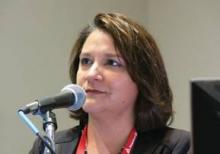SAN FRANCISCO – Hemoglobin A1c levels fell by 2.4% in veterans with diabetes whose primary care physicians referred them to a 6-month pharmacist-led intense management clinic, compared with a 0.2% drop in similar patients who did not attend the clinic.
That translates to a $9,104 reduction in estimated 3-year medical costs for each patient seen in the clinic and a $1,803 drop in costs in the comparison group, reported Candis M. Morello, Pharm.D. The changes in HbA1c and costs in the intervention group were significant, compared with the nonclinic group.
After factoring in the $61,992 cost of the pharmacist over 3 years, $7.81 would be saved for every $1 spent on the program, said Dr. Morello of the University of California, San Diego, and director of the diabetes intense medical management clinic in the Veterans Affairs San Diego Healthcare System.
The clinic is a collaborative practice between an endocrinologist and a doctor of pharmacy who also is a certified diabetes educator and has full prescribing privileges. The pharmacist spends 4 hours/week in the clinic and 3 hours/week on phone follow-up calls to manage 60 patients per year who have HbA1c levels of at least 8%, high comorbidity, and complex medication regimens.
Patients are referred by primary care providers for the 6-month "tune-up" clinic involving three to five hour-long, one-on-one visits between the patient and the pharmacist. After that, patients return to their primary care providers but can make follow-up phone calls to the clinic.
The tune-up focuses on finding the best combination of medications for the individual patient, education on medication adherence, simplifying the drug regimen to fit around the patient’s schedule, and setting personalized goals.
The study compared clinic patients with a random sample of patients treated by primary care providers in the same time period. Initial HbA1c levels were 10.5% in the clinic group and 9.3% in the comparison group, Dr. Morello and her associates reported at the annual scientific session of the American Diabetes Association.
They used a published regression model applied to retrospective chart data to estimate the 3-year costs of medical care (Diabetes Care 1997;20:1847-53). Based on baseline health status (largely driven by HbA1c levels), estimated costs per patient were $42,032 in the clinic group and $37,065 in the comparison group. Assuming that HbA1c changes were maintained 3 years later, estimated costs of care were $32,928 in the clinic group and $35,262 in the comparison group.
For 60 patients seen per year in the clinic, that amounts to a cumulative potential $546,240 savings from reduced costs, for a benefit-to-cost ratio of $8.81 and a return on investment of $7.81, she said.
If mean HbA1c levels rise by 1% over 3 years, the estimated medical cost avoided would be $6,412 per patient in the clinic group, still better than results in the comparison group, a secondary analysis found. That adds up to $384,720 in costs avoided over 3 years, for a benefit-to-cost ratio of $6.21 and a $5.21 return on investment after factoring in the cost of the pharmacist.
"I’m pretty sure that spending a little bit of money on the front end saves money on the back end," Dr. Morello said.
She reported having no financial disclosures.
On Twitter @sherryboschert


